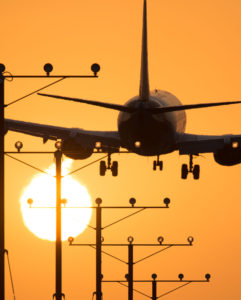
Photo: 123RF
Approaching to land on an Instrument Landing System
How do pilots land when they can’t see the runway?
Bhavin from Quora asks the above question. The simple answer is that you do not land because it is too dangerous to guess where the runway is! As such, you will abort the landing and make a second attempt or divert to an airfield with better visibility
To land or not to land is a very crucial decision for a pilot. It all depends on the height and the visibility ahead of the aircraft.
The next criterion is the skill or certification of the pilot in flying under instruments, an aviator’s jargon for flying blind or inside the clouds where you cannot see anything outside.
The third requirement is that the plane must be flying under the guidance of an instrument landing system (ILS).
For instance, an experienced pilot flying on an ILS up to 200 feet above the runway requires a visibility of 550 meters before he can legally land. Technically, he is not allowed to go below this height or else he will fail if he is being checked by an examiner.
Such limitations are based on the environmental conditions.
However, the captain has the choice to auto land the plane if he thinks the visibility is bad. In such a scenario, he is allowed to descend to 23 feet with 100 meters forward visibility on an Airbus plane. If these conditions are not satisfied, he must abort the landing.
So Bhavin’s question will be clearer if he specifies the height because at 1000 feet, he may not see the runway yet. He should NOT go around because he has not reached the minimum decision height.
It all depends on the experience of the pilot. Generally, the height for his decision making is at 200 feet. However, a certified pilot can descend to 23 feet decision height on automation.
The ILS is basically a very accurate guidance system for a plane to land. There are other less accurate navigation landing aids with higher decision heights.
On 2010, a Russian Tupolev Tu-154 plane crashed near the Russian city of Smolensk, killing all 97 people on board. Among the victims were the president of Poland and his wife.
The pilot had been warned about the poor visibility and was urged to divert to Moscow. However, he proceeded to land when he could not see the runway. Investigation revealed that the aircraft was off by 40 meters from the extended runway centerline.
In general, examiners are very stringent, ensuring no pilots descend below the safety minimum height during an instrument approach.
The auto landing system makes flying very safe in bad weather today. During the final approach, it comes out with a warning “HUNDRED ABOVE”, alerting the captain that he is 100 feet to his decision height. If he can see the runway, he will call out, “CONTINUE” and lands the plane
If he cannot see the runway, the standard procedure is for him to say ‘GO AROUND FLAPS!”, simultaneously pushing the thrust levers forward and fly away safely for another day!
See video on an Airbus A320 doing an auto land into Munich Airport here https://www.youtube.com/watch?v=Kf3EWKdW4oI